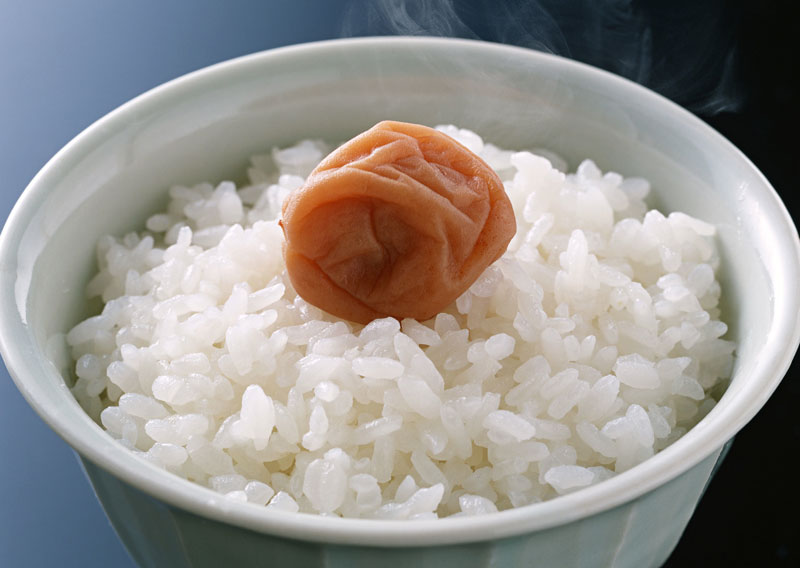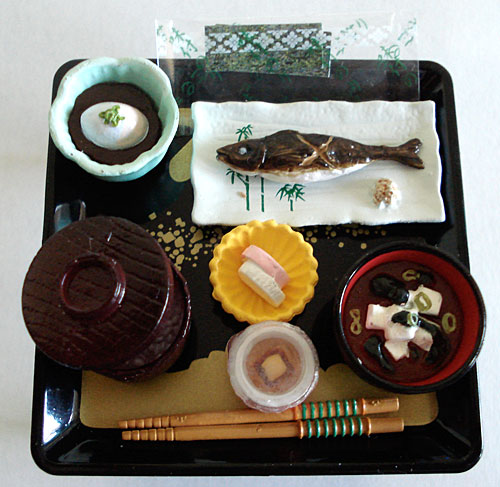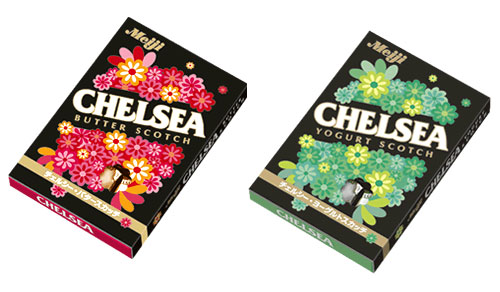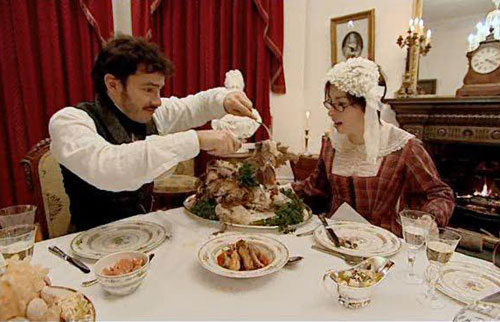Features (articles)
100 Japanese foods to try

This is a list I originally created in 2006. I haven't really revisited it since then, but I have cleaned up some unnecessary cruft (i.e., you no longer have to click on something to see the descriptions). I may come up with another list sometime....
What 100 Japanese foods would I recommend people try at least once?
I tried to keep away from foods that are only available in certain regions, or even certain restaurants or homes (e.g. my aunt's homemade udon) and stuck to foods that are widely available in Japan. I've also tried to include foods from all categories and all price ranges, from wildly expensive matsutake mushrooms to cheap and sometimes not so good for you snacks. I also did not limit the list to 'genuine Japanese' foods (純和風), but include Western-style yohshoku dishes and a sprinkling of chuuka (imported Chinese) foods that are so ingrained in Japanese food culture that most people barely think of them as Chinese any more. And of course, I have eaten all of the foods listed at least once - in most cases many, many times. I like them all!
The list is not numbered in order of preference. It's just how I happened to list them.
What, no sushi?!
Nigiri-zushi and the most common types of sushi are not on the list, because I am assuming that if you are reading this, you've already had sushi. (Though... are you sure you've had great sushi at a top notch sushi-ya? See Judging a good sushi restaurant.)
A List of 100 Japanese Foods To Try At Least Once
- Properly washed and cooked, top quality new harvest white rice (shinmai 新米) I cannot emphasize enough the importance of rice in Japanese cuisine. The ultimate rice for most Japanese people comes from famed rice growing areas such as Niigata prefecture or Akita prefecture; famous varieties include _koshihikari_ and _sasanishiki_. And the best tasting rice is held to be new harvest rice or _shinmai_ 新米. The older rice gets, the less desirable it is. This differs from some other rice cultures where aged rice (e.g. basmati rice) is held in high regard. See also How to cook Japanese rice.
- Freshly made tofu, as hiyayakko or yudofu Tofu used to be sold by mobile street vendors, who would go around neighborhoods in the evening (just before dinnertime) tooting a loud horn. Housewives would rush to the vendor cart, bowls in hand, to buy fresh tofu. Nowadays mobile _tofu-ya_ have virtually disappeared in Japan, but small independent tofu stores do still exist. Most people just buy tofu from a supermarket or _combini_ though. See how to make your own tofu; how to make hiyayakko and agedashi dofu (another great way to enjoy tofu). Yudofu (湯豆腐)is a piping hot version of hiyayakko.
- Properly made misoshiru and osumashi Misoshiru 味噌汁 is miso soup, an osumashi おすまし is clear soup, both fundamental parts of a traditional Japanese meal. Some people have a bowl of miso soup or clear soup at every meal. The difference between a miso soup made with proper dashi stock and good miso and an ersatz 'instant' one is like night and day. See Miso and miso soup basics and A week of miso soup.
- Properly made homemade nukazuke Nukazuke 糠漬け are vegetables pickled in a fermente rice-bran (nuka 糠)bed or nukadoko (糠床). The vegetables are only left in the pickling bed for a few days. The care and feeding of a good nukadoko is a complex, much discussed matter, similar to the cult surrounding sourdough. The housewife or restaurant that has a top notch nukadoko is much respected. Unfortunately, nuka pickling at home seems to be a slowing dying art.
- Very fresh sanma (saury), sizzling hot from the grill, eaten with a drizzle of soy sauce and a mound of grated daikon radish Simply grilled fresh fish is a keystone of Japanese meals. Smaller fish such as sanma or the higher-class aji (horse mackerel) are grilled whole with their skins on, heads intact and innards left in, including sperm sacs or eggs. All parts of the fish are considered edible, and the innards are considered to be delicacies. Blue/oily fish or hikarimono (ひかりもの) are at their best in the colder months when they have more fat. Sanma used to be considered to be poor peoples' food since it was so cheap.
- Homemade umeboshi Umeboshi (梅干し)- salted, dried then pickled ume (梅), a fruit that is a relative of the plum and the apricot. Very salty-sour, and acquired taste. Used in small quantities, it's a great flavor enhancer and appetite stimulant. Homemade is usually the best, and despite the effort it requires a lot of people still make their own umeboshi every year (including my mother). An acquired taste. See New rice and pickled plum and Oba-chan's pickled plums.
- Freshly made, piping hot crispy tempura. I prefer vegetable tempura like shiso leaves, eggplant and sweet potato. Tempura 天ぷら is considered to be a quintessential Japanese foo these days, but it's actually an early imported food, introduced by Portuguese and/or Spanish missionaries in the 16th century. (See Wikipedia.) Good tempura must have crispy, light-as-air, greaseless batter coating. The usual dipping sauce is a mixture of dashi stock, soy sauce and grated daikon radish called tentsuyu (天つゆ), not, as you might think from the way tempura-like fried foods are served in pan-Asian restaurants, sweet and sour sauce! (yeah yeah, I still haven't posted a tempura recipe here! Someday I'll fix that...)
- A whole grilled wild Japanese matsutake Matsutake (松茸)is a very fragrant, highly saught after, and __expensive as all heck__ mushroom. In Japan it grows near matsu (松)trees, which are supposed to greatly enhance their aroma. Matsutake are as highly regarded in Japan as truffles are in Europe. Japanese matsutake prices can reach four figures (in U.S. dollars) per kilo; imported matsutake are held in much lower regard, and are often sprinkled with 'matsutake essence' while cooking. The best way to eat a matsutake is to simply grill it over a hot charcoal fire, and sprinkle with a tiny amount of soy sauce and so on.
- Freshly made sobagaki with sobayu Soba (蕎麦)or buckwheat is best known in the noodle format. But the best way to enjoy soba in my opinion is as sobagaki (そばがき), a chewy-soft dumpling of sorts made out of fresh buckwheat flour, boiled in water. The cooking water is called sobayu (そば湯)and is sipped along with the sobagaki. This is a warm dish by the way.
- Mentaiko from Fukuoka, or tarako Mentaiko (明太子)and tarako (たらこ)are both marinated/salted pollack roe, even though the name tarako means "child of cod". Mentaiko is a spicy version, which originated in Korea and crossed the sea to the southern island of Kyuushuu. Fukuoka, the largest city in Kyuushuu, is famous for its mentaiko. Both tarako and mentaiko can be eaten as-is with plain rice, or used as a paste or sauce - see tarako and ponzu pasta. Tarako is often used griled until firm as an onigiri filling. (Mentaiko onigiri is not that common, probably because it's pretty expensive!) Tarako or mentaiko mixed with a bit of butter and spread on hot toast is delicous. An acquired taste.
- Onigiri with the three classic fillings: umeboshi, okaka, shiozake Okaka (おかか)is bonito flakes mixed with soy sauce; shiozake (塩鮭)is salted salmon. See Onigiri FAQ.
- Assorted fresh-as-possible sashimi Sure sushi is great, but the ultimate indulgence at a sushi-ya for me is a selection of fresh sashimi; it's beautiful to behold and a treat for the tastebuds. Be adventurous and try everything form raw (live) shellfish to raw squid to slices cut from a still live fish! (This is called ikezukuri (活け造り or 生け作り)Yes I know, it's cruel, but it's very Japanese.)
- Saba oshizushi 鯖押し寿司 is sushi you won't often encounter in sushi restaurants, though some Japanese restaurants do have it on their menus. It is a speciality of Okayama prefecture, but is popular all over Japan. Very fresh mackerel or saba (鯖)is fileted, salted and marinated, then pressed firmly onto a block of sushi rice; the whole is then left to rest for a few more hours. It's a style of sushi that is much older than the nigiri-zushi you are probably familiar with.
- Mugicha 麦茶. See Mugicha article.
- Kakifurai 牡蠣フライ - breaded and deep fried whole oysters, a yohshoku dish. You may not think this is that Japanese...but that crispy, slightly bitter, creamy-seafoo flavor, eaten with Bulldog sauce, is very Japanese to me, an is something I really miss! (Oysters in Switzerland are Way Way Too Expensive.)
- Morinaga High-Chew candy, grape flavor I know I'm biased, but I think Japanese confectionery companies make the best tasting candies. I didn't say chocolates or candy bars - I mean candies, or sweeties if you are of British inclination. Morinaga's High Chew line of soft chewable candies are among the best and most popular, and of these the grape flavor is my
- Karasumi
からすみ is salted and dried mullet roe. It has a very dense, sticky yet waxy texture (sort of like a salty-fishy an not sweet fudge), and is very salty. It's one of the 3 great delicacies, or chinmi (珍味)of Japan; the others are salted sea urchin (shiuni) and sea cucumber innards (konowata), both of which are sort of stomach-turning for me, but karasumi is an oddly addictive substance. You traditionally eat tiny slices of it to accompany your sake. Very much and acquire taste.- A pot of oden, preferably with homemade components especially ganmodoki, boiled eggs and daikon radish
おでん - see oden article and recipe.- Ika no shiokara
いかの塩辛 is cuttlefish squid that is salted and fermented in its own innards. It has a slimy sort of texture, and a very intense sea-flavor. Great on hot rice. An acquired taste. Easily obtainable in jars at larger Japanese grocery stores; if you can get very fresh squid with the innards you can make your own at home. This recipe on Chowhound should work well, but use a non-reactive, glass or ceramic container; this is powerful stuff that will at the very least stain and odorize a plastic container forever, and may even eat through thin plastic (I've had this happen...)- Calpis
カルピス is a sweet fermented milk beverage. It's most commmonly sold as a concentrate, which is mixed with cold water or plain at a 1:5 or so ratio. It's also used straight as a syrup over shaved ice (kakigouri かき氷), and as a mixer in some cocktails. Because of its fermented flavor, cloying mouthfeel and (for English speakers) rather unfortunate name which sounds like 'cow piss', it hasn't seen a whole lot of success in the West, though as "Calpico" in already diluted or soda form it is sold in some parts of Asia. An acquired taste. Japanese people love fermented-milk flavor (see Yakult below). (Switzerland also sells a fermented-milk beverage called Rivella, which tastes a bit like Calpis/Calpico soda.)- Ankou nabe
あんこう鍋 - monkfish hotpot or stew. Tabletop cooking is very popular in Japan. A small portable gas burner is placed in the middle of the dining table, a variety of cut up vegetables and some kind of protein are made ready, and they're cooked in a pot (in which they are called nabemono 鍋物 or simply nabe 鍋)of simmering water/broth, on a grill or shallow pan. Everyone at table picks out the pieces they want. Ankou is monkfish, a rather slippery, chewy fish with tons of flavor; together with lots of vegetables it makes a delicious nabe on cold winter days.- Unadon
うな丼 is unagidonburi (うなぎどんぶり)shortened; it's eel filets with a sweet-salty sauce on a bed of rice. A very rich, high calorie dish that's popular in the summer months, since all those calories in eel are supposed to keep your strength up!- Komochi kombu or kazunoko
Kazunoko (数の子) is brined herring roe, and komochikonbu (子持ち昆布)is the same herring roe pressed onto konbu seaweed. Both have a distinctive crunchy texture and the salty flavor of the sea. An acquired taste.- Yamakake, grated yamaimo with maguro (red tuna) cubes (or just tororo with a raw egg)
Japanese people love food with a slippery, slimy texture, and the slimiest of them all is grated yamaimo (山芋) or nagaimo (長芋), a type of yam. This is called tororo (とろろ, not totoro!). My form of tororo is when it's combined with cubes of fresh tuna, which is called yamakake (山かけ), but the ultimate slimy experience is tsukimi tororo (月見とろろ), a bowl of grated yamaimo with a raw egg which is supposed to look like a full moon.- Properly made gyokuro shincha
玉露の新茶、new-crop Gyokuro green tea. How to brew a perfect cup of green tea.- Milky Candy
ミルキーキャンディー is a classic candy, with a character called Peko-chan who has graced the packaging since 1950. It is made by Fujiya (不二家). It tastes like condensed milk in candy form, and is another example of how Japanese people like that sweet, rather curdled milk taste.- Wanko soba
ワンコ蕎麦 or わんこそば. I'm breaking my 'no regional food' rule a bit, though you can get wanko soba outside of the region where it's a speciality (the Iwate prefecture in the north). Wanko soba is served in small bowls filled with a very strong tsuyu or soba sauce (cold) with various condiments (see Cold soba with dipping sauce). The customer holds the bowl out, into which the servers throw in a few strands of soba noodles. The customer slurps these up rapidly, and more strands are thrown in. This is repeated until the eater is full. An average male eater can consume about 60 servings. It's a gimmick, and encourages rapid eating. Wanko soba eating contests are the precursor of extreme eating competitions which are so popular in Japan.- Omuraisu with demi-glace sauce
オムライス is another example of yohshoku. The best place to have an omuraisu is at a small restaurant that specializes in yohshoku and makes their own demi-glace sauce. Failing that, a quick homemade version with ketchup is almost as nice. It's a big with kids in Japan.- Handmade katayaki senbei
煎餅 - せんべい - means rice cracker, but the little snack-sized rice crackers that are now as common as potato chips around the world are at the bottom of the rice cracker quality scale. At the top are hand-crafted 堅焼き煎餅 (katayaki senbei); round rice crackers the size of your palm or bigger, made of pounded rice that is formed by hand, dried under the sun, and toasted over a charcoal fire until the rice patty pops and forms crunchy air pockets. It is then painted with dark soy sauce. The sweet version is then sprinkled with big grains of salt caled ざらめ (zarame).- Yohkan (yokan) from Toraya
羊羹 - ようかん - is a dense, fudge like cake of sweet azuki beans; sometimes it contains chestnuts or other ingredients. To be eaten in slowly, in tiny mouthfuls, with green tea. The best yohkan is widely held to be from the old wagashi maker Toraya (とらや); a gift in a Toraya bag has much cachet throughout Japan.- Ishi yakiimo
石焼き芋 (いしやきいも) are sweet potatoes cooked in hot stones, available from street vendors; a fixture on cool fall evenings. See Hoku-hoku is fall.- Natto
納豆(なっとう)- fermented, sticky/slimy soy beans. The quintessential 'eww' Japanese food item. Definitely an acquired taste. See Natto article and The Great Natto Diet Rush.- Fresh seaweed sunomono (can also have some tako in it)
酢の物(すのもの)- a salad of sorts, usually with seaweed and/or seafood, with a slightly sweet, oil-less vinegar dressing. Very low in calories and very refreshing. The best is made with fresh seaweed, tasting of the sea; some chunks of fresh tako (タコ) or octopus are a nice addition. See wakame no sunomono recipe using dried wakame seaweed, which is all we can get here in landlocked Switzerland...(cries)- Ikura or sujiko
Sujiko - すじこ is salmon eggs still encased in the egg sac, while ikura - いくら is the eggs removed from the sac membrane. Both are cured in salt or soy sauce and eaten raw. The best way to enjoy either is to just mound it on top of a bowl of rice, perhaps with a little grated fresh wasabi. A speciality of Hokkaido.- Tonkatsu
トンカツ or 豚カツ is a breaded and deep-fried pork cutlet, a typical yohshoku dish. See Tonkatsu recipe.- Goma dofu
胡麻豆腐 is an example of shoujin ryouri (精進料理), the refined vegan cuisine developed by Zen Buddist monks. See goma dofu recipe.- Chawan mushi or tamago dofu - the same dish either piping hot or ice cold
Chawanmushi - 茶碗蒸し is the hot version of tamago dofu - 卵豆腐; both are delicate, smooth, savory egg custards. See Tamago dofu recipe.- Freshly made mochi, with kinako and sugar, grated daikon and soy sauce or natto
Mochi - 餅 or pounded sweet rice, is available in many forms. As a symbol of bounty a tier of two or three rounds of mochi are placed in front of the Shinto altar in the home for the New Year (called kagami mochi). The best mochi is freshly pounded, eaten with brown sugar and kinako (toasted soy bean powder), or with grated daikon radish and soy sauce, or even with natto and green onions. That's the way they were served at my grandparents' house when I was very little.- Gindara no kasuzuke
銀ダラの粕漬け is gindara, or silver cod, marinated in sakekasu (酒粕), sake lees mixed with other ingredients such as salt or soy sauce, mirin, and so on. The fish is marinated for a day or more, then grilled. The sweet-salty taste of the marinade permeates the firm fish and the result is heavenly.- Hoshigaki
干し柿 are dried persimmons (kaki). Bitter persimmons (渋柿 shibugaki) are hung outside to dry slowly; the bitter liquid drips out as the fruit dries, leaving a densely sweet delicacy. The bitter liquid is saved and used to lacquer wooden bowls and boxes.- Inarizushi
Sushi rice stuffed into fried bean curd (油揚げ aburaage) pockets. Typically a homemade sushi, rather than one served in a sushi restaurant. See Inarizushi recipe.- Chikuzen-ni
筑前煮 ちくぜんに is a homely dish in which cut up chicken, lotus root, carrots, taro root, burdock root, shiitake mushrooms etc. are stewed together in a dashi broth. It is made in large quantities for the New Year's period, when it's heated up daily and eaten during the holidays (giving the cook of the household a break from daily cooking). It can be eaten at any time of the year though, especially the cold months. Filling and healthy!- Surume
するめ is salted and dried squid' it's chewy, rather like squid jerky. It is usually eaten shredded into fine strips; you can get it like that, or the whole squid (better quality surume is usually sold whole, to be grilled briefly at home). A standard snack to accompany sake (おつまみ otsumami - see Yakitori below). My stepfather loves freshly grilled surume with a little mayonnaise and chili pepper (ichimi or nanami tougarashi).- Yakinasu with grated gingerfav44
焼き茄子 やきなす - grilled eggplant, with しょうが shouga (ginger) and a bit of soy sauce, is a summertime The slim eggplants are grilled whole, without any oil, until they soften and the skin bursts; the charred skin is then peeled off, leaving the flower bract. The peeled eggplant is eaten ice cold.- Tamago kake gohan
卵かけご飯 たまごかけごはん is just hot, freshly cooked white rice with a raw egg plus a little soy sauce. To make this, mound a rice bowl with rice, and make a hole in the middle. Drop in a fresh egg an add soy sauce; mix. A breakfast- Kabuki-age
歌舞伎揚げ is a round, deep fried rice cracker that has a distinctive crackly surface. It originated as a snack served at 歌舞伎 かぶき kabuki theaters, allegedly. Nowdays it's a cheap and rather fattening snack.- Nikujaga
肉じゃが - Japanese meat and potatoes, quintessential お袋の味 おふくろのあじ ofukukuronoaji ("mother's cooking"). See my mom's nikujaga recipe.- Spinach gomaae
ほうれん草のごま和え ほうれんそうのごまあえ hourennsou no gommae - more "mother's cooking". Spinach, and other dark green leafy vegetables are always served cooked in traditional Japanese cuisine, usually quickly blanched as a side dish. Besides sesame dressing, a simple お浸し おひたし ohitashi (dashi stock and/or bonito flakes and soy sauce sauce) is also very popular. See how to blanch spinach, and gomaae and ohitashi recipes.- Fuki no tou
ふきのとう - butterburr shoots, blanched and de-bittered and cooked in a typically Japanese sweet-salty sauce. Since butterburr shoots are only available in the spring, this is a very seasonal dish. Other highly treasured spring vegetables include わらび warabi - bracken fern (shoots), よもぎ yomogi - a type of chrysanthemum, and 筍 たけのこ takenoko - bamboo shoots.- Okonomiyaki
お好み焼き おこのみやき - popular street food, originating in Osaka but now popular all throughout Japan and beyond! Often erroneously called Japanese pizza, I think it's more aptly described as a savory pancake. See Osaka style okonomiyaki recipe.- Yakitori
焼き鳥 やきとり - skewered and grilled chicken bits. Very popular street food and 酒の肴 さけのさかな sake no sakana - drinking snack. (Competition between Japanese 居酒屋 いざかや izakaya - traditional pubs for the quality of their sake no sakana (also called おつまみ otsumami) is fierce, just like tapas in Spain.)- Ohagi
お萩 おはぎ - a traditional sweet, eaten in the fall. Very similar to ぼた餅 botamochi. See Ohagi/botamochi recipe.- Japanese style curry, with rakkyo and fukujinzuke as condiments
カレーライス kareh raisu is different from other curries! See recipe and a bit of the history of 'curry rice' in Japan.- Kenchinjiru
けんちん汁 けんちんじる is a clear yet hearty vegetable soup. It is one of the most famous 精進料理 しょうじんりょうり shoujinryouri (a refined vegan cuisine developed by Zen Buddhist monks in the Kansai region) dishes. A variation of kenchinjiru with bits of pork in it is called 豚汁 とんじる tonjiru.- Yakult
ヤクルト is a sweet, slightly fruity, fermented probiotic milk drink that is supposed to be good for your digestive system. It's sold all around the world now, with plenty of imitators. Included here because it is really very post-war-Japanese. Also see Kalpis above (which doesn't make probiotic claims, but has a similar taste).- Kakipea
A snack made up of spicy little rice crackers called 柿の種 かきのたね kaki no tane (literally: persimmon seeds) and roasted peanuts. See needlessly long and obsessive article.- Takoyaki
たこ焼き たこやき - another popular street snack that originated in Osaka. Puffy creamy doughy balls with a piece of octopus inside, served with a sauce. Best eaten piping hot. Frozen takoyaki are a pale, sad approximation of freshly made takoyaki. See takoyaki recipe (the video referenced is no longer available, but you can still follow the instructions I hope!)- Sakura mochi
桜餅 さくらもち is a traditional sweet that is eaten in spring, to coincide with the cherry blossom season. Sticky rice that is half-beaten and dyed a pale pink is wrapped around 餡 あん an - sweet azuki bean paste. The whole thing is then wrapped with a preserved cherry tree leaf, which is slightly sour-salty.- Buta no kakuni
豚の角煮 ぶたのかくに - braised pork belly. Similar to a Okinawan dish called ラフテー - rafuteh. Japanese people eat a lot more pork than beef (other red meats are not eaten much). The butcher in my grandparents' town in Saitama prefecture (right next door to Tokyo) didn't even carry beef until the 1980s. See Buta no kakuni recipe.- Daigaku imo
大学芋 だいがくいも literally means "university potato", probably because this hearty sweet snack is sold at the big university festivals that are held in the fall. Sweet potato chunks are deep fried then dipped in sugar syrup, which forms a hard, caramel-flavored coating, then sprinkled with sesame seeds.- Kappa Ebisen
かっぱえびせん is a puffy, crunchy shrimp flavored snack, manufactured by Calbee. Yes, Japanese cuisine purists will turn their noses up at this selection no doubt! But I love Kappa Ebisen, it's very Japanese, and it's here. It actually has ground up shrimp in it, so the maker claims that it's a good source of calcium!How Kappa Ebisen is made (Flash page in Japanese).- Tori no tsukune
鶏のつくね とりのつくね - soft stewed chicken dumplings. Another example of 'mother's cooking'. Fish tsukune (mainly made of oily fish like herring or mackerel) are also popular. Chicken tsukune recipe.- Hakusaizuke
白菜漬け はくさいづけ is salt pickled nappa or Chinese cabbage, a pickle for the cold winter months. (This is turned into kimchi in Korea.)- Hayashi raisu
ハヤシライス is Japanese beef stew. See recipe and main article.- Goya champuruu
ゴーヤチャンプルー is perhaps the best known dish of Okinawan cuisine. Its main feature is the use of bitter gourd, which is stir-fried with pork, egg and tofu to make a hearty dish. It's supposed to give you lots of energy yet cool your body at the same time, making it perfect for the tropical climate of Okinawa.- Dorayaki
どら焼き どらやき is another traditional Japanese sweet (wagashi). Sweet azuki bean paste is sandwiched between two small pancakes.- Ochazuke
お茶漬け おちゃづけ is rice with various salty/savory toppings, over which hot green tea is poured. It's often served as the last course in a formal Japanese meal, and it's also a popular midnight snack. See main ochazuke article.- Sakuma Drops
佐久間ドロップ or サクマドロップ are fruit flavored hard candies manufactured by Sakuma Seika. (Seika means 'confectioner'; there are actually two companies called Sakuma Seika, both manufacturing hard candies, run by rival members of the same family!) The candies are coated with powdered sugar, which prevents them from sticking together, and come in a reclosable can. This candy bridges the gap between traditional Japanese sweets and postwar 'modern' sweets; while hard candies existed previously, the fruit flavoring was quite new at the time. Sakuma drops featured prominently in the Studio Ghibli movie Grave of the Fireflies (火垂るの墓). Sakuma Drops are on this list to represent the many delicious hard candies available in Japan! See also Meiji Chelsea.- Stewed kiriboshi daikon
切り干し大根 きりぼしだいこん - shredded and dried daikon radish. There are many dried foods in Japan, which are still eaten regularly even if drying as a method of food preservation is old-fashioned. See Dried vegetables.- Takenoko gohan (or in fall, kuri gohan)
竹の子ご飯 たけのこごはん is rice cooked with fresh bamboo shoots; 栗ご飯 くりごはん is rice cooked with sweet chestnuts. One signifies spring, the other fall. More 'mother's cooking'!- Cream or potato korokke
コロッケ korokke is the Japanese version of croquettes. While you barely see croquettes much these days in the West outside of restaurants, in Japan they are an everyday food, part of yohshoku. You can buy them frozen or freshly made at any supermarket or convenience store, and many people make them from scratch at home too. クリームコロッケ kureemu korokke - cream croquettes - are made of stiff bechamel (white) sauce, usually with crabmeat or shrimp in it, and ポテトコロッケ - poteto korokke are made of mashed potatoes plus something else (ground meat, corn, etc). Usually served with the ubiquitous Bulldog Sauce.- Fresh yuba
湯葉 - is a Kyoto speciality. Thin films of tofu are scooped off the top of vats of warm soy milk. It’s available in dried form and is usually used in soups and such. Fresh yuba made from fresh warm soy milk is considered a great delicacy and is usually eaten with a litle soy sauce, yuzu juice and such. Yuba is part of shoujinryouri.- Real ramen
ラーメン is imported from China, but has been adopted wholeheartedly by Japanese people. One only needs to watch the movie Tampopo once to see how obsessed Japanese people can get about good ramen.- Monaka
最中 もなか is another traditional sweet. A crispy waffle-like casing is filled with sweet azuki paste (an), a sweet custard-cream, or ice cream.- Ekiben of all kinds
駅弁 えきべん are bento lunches served at train station. They are one of the best ways to sample local delicacies around Japan fairly economically. If you can't travel around on trains throughout Japan, you can try the ekiben sold in department store food halls. A bit more about ekiben here.- Edamame
枝豆 えだまめ - the quintessential summertime beer snack, now famous around the world. Addictive, more-ish yet healthy - how can you go wrong with edamame?- Chicken karaage
とりの唐揚げ とりのからあげ tori no karaage. Another imported-from-China and adapted to Japan food. My kind of fried chicken! See recipe.- Kuzumochi
葛餅 くずもち - a cool summer sweet made from kuzu powder. See recipe.- Mitarashi dango
みたらし団子 みたらしだんご - yet another traditioan snack: sticky mochi rice dumplings coated in a salty-sweet sauce. Mitarashi dango recipe.- Konnyaku no dengaku
こんにゃくの田楽 こんにゃくのでんがく - Konnyaku served hot on a skewer with a salty-sweet dengaku sauce, which is made with miso, sugar and other things. Barely any calories! See more about konnyaku.- Yukimi Daifuku
雪見大福 ゆきみだいふく is a daifuku (mochi dumpling) filled with vanilla ice cream rather than the traditional sweet bean paste. A fairly recent invention, it's not-too-sweet and very nice on a hot day.- Sukiyaki
すき焼き is a dish from the Kanto/Tokyo area. Thin slices of beef are cooked in a shallow pot, usually on a tabletop gas burner, in a sweet-salty 'sauce' made in the pot by combining sugar, a bit of sake and soy sauce. After the meat gets going, vegetables, tofu, shirataki noodles and udon noodles are added to the pot. The 'dipping sauce' is a raw egg. At-home family cooking at its finest!- Nama yatsuhashi
生八つ橋 なまやつはし is a traditional refined sweet from Kyoto flavored with nikki or cinnamon. See yatsuhashi recipe.- Panfried hanpen
はんぺん is a airy-light fish cake, made of ground up white fish, yamaimo and egg white. It's commonly available readymade in any food store, but I think it has a refined flavor and texture to rival any French quenelle or the like. It is used in soups, stews, and so on, but my way to eat it is to just panfry it in oil or butter until golden brown. It's also good stuffed with a ground meat mixture.- Nozawanazuke or Takanazuke
野沢菜漬け のざわなづけ and 高菜漬け たかんづけ are a traditional preserved mountain food: freeze-dried greens that are salted down. Very nice as onigiri wrappers.- Kiritanpo
きりたんぽ is a traditional food from the north of Honshuu, especially Akita prefecture. Pounded rice cakes are formed around a skewer and grilled. These are the eaten as-is with a little soy sauce or miso, or put into soups and stews. Chewy, doughy and very Japanese.- Amanattoh
甘納豆 あまなっとう - unlike regular natto, amanatto (sweet natto) are not sticky or fermented; they are just beans with a crystallized sugar coating. A traditional sweet snack, eaten especially around the end of the year.- Narazuke
奈良漬け ならづけ could be the oldest known pickle in Japan. A speciality of Nara, the first capital of a unified Japan, various vegetables like gourds and cucumbers together with ginger are pickled in sake lees. The sake lees are changed several times before the pickles are ready. The resulting pickles are semi-transparent and sweet. Related: wasabizuke, vegetables pickled in wasabi mixed with sake lees.- Aji no himono
アジの干物 - 干物 ひもの himono means dried fish. Dried fish in Japan is usually not dried to a cardboard-hard state, but rather eaten when still a bit soft. Aji or horse mackerel is delicious dried or semi-dried, cured with just salt or with a sweet mirin coating (this is called mirin boshi).- Baby Ramen
ベビーラーメン, or officially ベビースターラーメン is a salty snack that looks like little dried bits of instant ramen - it probably is bits of instant ramen, deep fried for good measure. It comes in little packets which are all connected in one long strip, useful for hanging up in a small store. Small snack and confectionary stores called 駄菓子屋 だがしや (dagashiya) used to exist in every neighborhood, selling homely snacks like Baby Ramen and Botan Candy, but they are now sadly a thing of the past, existing only in Showa-era 'amusement parks' and the like. The good news is that Baby Ramen still survives. Update as of 2010: Dagashi stores seem to be making a slow comeback, on the wave of a general trend for Showa era nostalgia.- Kobucha
昆布茶 こぶちゃ - also read kombucha, but do not confuse it with the drink from the mystery Russian mushroom. This is a 'tea' made with salty pieces of soft konbu seaweed. It is drunk as a tea, even though it 's salty - rather like British people drink Bovril dissolved in hot water. It can also be used as an instant dashi.- Kasutera
カステラ - a Japanese spongecake that came via Portugal from Spain in the 17th century. Sweet and airy, usually with a honey flavor. See kasutera recipe.- Tazukuri
田作り たづくり is a traditional dish that is part of お節料理 おせちりょうり - osechiryouri, New Year's feast cooking. It consists of tiny little dried fish that are cooked in a sweet-salty sticky caramel like sauce. Sesame seeds are added too. The numerous little fish signify a wish for a good harvest and prosperity (little fish like this apparently used to be used as fertilizer in the rice fields.) In old Japanese tazukuri is called ごまめ gomame.- Karintou
かりんとう is another traditional Japanese snack. Bits of flour dough are deep-fried, then coated in dark brown sugar caramel. Karintou is here because my mother told me that this was the main snack of her childhood, made at home by her mother. I used to hate karintou when I was younger, because they were so hard and looked like poo, but now I crave it...- Sauce Yakisoba
ソース焼きそば; yakisoba is of course derived from Chinese lo mein, but the Japanese version made with Bulldog sauce is well, very Japanese. A typical street stall snack.- Kamaboko
かまぼこ is a rather rubbery firm fish cake, rather like a fish sausage in texture. It is usually formed on a small wooden board. It's often dyed pink on the outside, and pink and white alternating slices of kamaboko are a part of お節料理 おせちりょうり - osechiryouri, New Year's feast cooking. Kamaboko is eaten year round as a side dish.- Oyako donburi
親子丼ぶり おやこどんぶり - literally 'parent-child bowl'. A donburi is both the name of the container (bowl) as well as the name of the food which is served in it - various things on top of a bed of plain rice. An oyako donburi consists of chicken pieces and vegetables encased in half-scrambled egg. Other donburi include gyuudon (beef donburi), tendon (tempura donburi), katsudon (tonkatsu donburi), tekkadon (raw tuna cube donburi), and so on and on. Typical lunch food.- Atsuyaki tamago
厚焼き卵 あつやきたまご - thick, slightly sweet Japanese omelette, a fixture in bento boxes and on sushi. See Tamagoyaki recipe which uses a frying pan (traditionally it's made in a special square pan, but I don't have one!)- Kuri kinton
栗きんとん くりきんとん is another part of お節料理 おせちりょうり - osechiryouri, New Year's feast cooking, consisting of whole chestnuts cooked in sugar syrup in a sweet potato paste that is dyed yellow with a gardenia seed. The golden colors of the dish signify a wish for good fortune in the coming year.- Japanese potato salad
Japanese potato salad (ポテトサラダ)is made with plenty of Japanese mayonnaise (which is rich and slightly sweet) and is served cold, often as an accompaniment to a hot dish like grilled fish. Japanese people love mayonnaise. See Japanese potato salad recipe.More lists?
Also see Diane's 100 Chinese foods to try before you die on Appetite for China!
Want more lists? The Big List of Must Eat Lists.
Filed under: japanese ingredients offbeat listsAbout Japanese ingredients and substitutions
[Updated to add Substitution section.]
See also: Sake and mirin redux etc.
I haven't exactly counted it up, but of the thousands of comments left on Just Hungry, not to mention Just Bento, probably at least a quarter are questions about ingredients or ingredient substitutions. So I thought I might put down what my criteria are for what kind of ingredients I choose to feature in the recipes on either site, especially when it comes to Japanese recipes. [Update added on August 15th, 2008]: I've also added some suggested, and acceptable, substitutions.
Can I get a hold of it?
In case you didn't know, at the moment I live in a country with a fairly miniscule Japanese expat or immigrant population (the last I heard there were less than 2000 Japanese people living in the Zürich area). There is only one real Japanese grocery store near me, and it is quite small with a limited selection of products. There's also an equally small (though slightly better stocked) Korean grocery store, and a couple of Chinese grocery stores. (See Where I shope for Japanese/Asian ingredients in Zürich.) I supplement what I can get locally by placing an order with Japan Centre a few times a year.
My point is, that what I can get is fairly limited compared to many people, though more generous than others. So by sticking to what I can get here, I think that I'm in a good middle ground for people trying to cook anything Japanese. If you live in a region (e.g. most of California, New York City, or Hawaii) with big Japanese expat/immigrant populations, you have a much bigger selection available to you than I do!
(My mom also sends me things from Japan periodically, but I do not include the more exotic things in the recipes here, though I might mention then in passing.)
Is it available by mailorder?
I also periodically check to see if certain ingredients are available online. Some online merchants don't have very comprehensive listings on their web sites, but by emailing them they can tell you if they have something in stock.
Where to look for Japanese ingredients
In order of the likelihood of finding Japanese ingredients:
- Japanese grocery stores, including online stores. This is obvious. Please consult the Worldwide Japanese grocery store list for your area, and go to your nearest store to see what they have! That's the best way to get acquainted with unfamiliar ingredients.
- Korean grocery stores. A lot of Japanese ingredients are used in Korean cooking.
- Chinese grocery stores and general Asian grocery stores. Chinese grocery stores tend to stock less Japanese ingredients than Korean grocery stores, but you can still find a lot of things.
- Health food stores, including online stores. Many dry and/or vegan ingredients, such as rice flour, kuzu powder, agar-agar, miso and so on can be found at health food stores.
- South East Asian grocery stores (Thai, etc.) These stores don't stock Japanese ingredients per se, but some of the fresh product and things can be used.
- South Asian grocery stores (Indian, Sri Lankan, etc.) These can be a surprisingly good source for 'exotic' vegetables and such that are used in Japanese cooking.
Is it a widely used ingredient in Japanese cooking?
In general, I try to stay away from any ingredient that might be considered to be too regional or esoteric in Japan, and stick to ingredients that are likely to be in any Japanese kitchen.
Is the recipe something that is normally made in Japan?
When I do traditional Japanese recipes here, I try to stick to ones that are commonly made in Japanese homes (vs. something exotic, regional or so complicated it's only available in restaurants).
The exception to this rule is when I try to make something that is readily available in Japan, but not necessarily elsewhere. An example of this is really fresh tofu. The hard work required is worth it for the results.
Ingredient substitutions
In certain cases, you can make substitutions without a problem. I try to include substitution recommendations whenever possible, or when I am fairly sure it would work. For instance, many Japanese recipes call for katokuriko (片栗粉)which is a flour made from potato starch, but this is hard to get outside of Japan in most places. Cornstarch (or cornflour) has a very similar texture and performs the same function, so that is an easy substitute. Using honey or syrup instead of maple syrup will change the flavor a bit but also works.
In some cases though there is no substitution. If you are making kuzumochi, you really can't use anything other than kuzu powder if you want the same texture.
Sometimes you just need to try out a substitution to see if it works. For instance, when I call for a specific rice flour like shiratama-ko or joushinko, but you can't get it, try substituting a rice flour you can get and see how it goes. (I 've made rice dumplings with red rice flour from Sri Lanka, and it turned out fairly well.) The worst that can happen is that you end up with an inedible dish that you have to throw away, but that's not the end of the world. Don't be afraid of making mistakes!
Some acceptable substitutions
[This section added on August 15, 2008]
- Mirin and sake. I think more people ask about substitutes for these two ingredients than anything else put together. Both are alcoholic beverages (though mirin is never drunk and is only used in cooking). Mirin is stronger and sweeter than sake. Sake can be used as a substitute for mirin (with an added pinch of sugar), and vice versa. If you cannot get a hold of either, you can use sweet sherry or Chinese shiaoxing wine. If you cannot use alcohol for religious or other reasons, even though most of the alcohol will evaporate after cooking, just leave it out - it will affect the flavor, but there's no reasonable non-alcoholic substitute that I can think of. See also: The role of alcohol, onion and garlic in Japanese meat dishes (also applies to fish dishes in many cases) (Vinegar is not a good substitute. Vinegar makes things sour. I can't believe there are people saying that vinegar is a substitute for sake. Is vinegar a good substitute for wine in a recipe? Please.) Mirin style seasoning or mirin choumiryou (example here) has less than 1% alcohol content, so it can be used as a mirin substitute in terms of flavor. However, mirin style seasoning often has additives like MSG and sugar, so I'm not a fan of it. If you do leave out mirin from a recipe, you can add a bit of (or more) sugar to the recipe to compensate for the sweetness at least.
- Japanese-style or sushi rice. Keep in mind that 'sushi rice' is a name given by non-Japanese sellers to Japanese style or japonica medium grain rice. Medium-grain Italian rices that are used for risotto, such as vialone and arborio, are acceptable substitutes for Japanese rice; long grain rices including basmati and jasmine rice are not.
- Dashi stock. Japanese stock is usually made from kombu seaweed, dried bonito flakes (katsuobushi), dried fish called niboshi, or a combination of all or two of these. (See basic dashi recipe.) You may find it difficult to find these ingredients, or they may be too expensive. Powdered or granular dashi stock is similar to stock cubes, and can be used instead of made-from-scratch dashi; keep in mind that dashi granules are saltier and often contain MSG. See also vegan dashi stock made with dried shiitake mushrooms and kombu seaweed. If you can't get a hold of any of these, you can use a basic vegetable stock instead - it won't taste that Japanese but it's better than plain water at least!
- Miso and soy sauce. There are no substitutes for these. As to whether you should stick to Japanese soy sauce or use other kinds - I do believe that Japanese soy sauce tastes quite different from, say, Chinese soy sauce, but your palate may not be able to detect a big difference. Kikkoman is the most famous Japanese brand, and is available worldwide.
- Japanese tonkatsu sauce or okonomiyaki sauce, or "bulldog" sauce. Bulldog is the brand name of a popular line of barbeque-type sauces that are used in a lot of dishes, from panfried noodles (yakisoba) to deep fried pork cutlets (tonkatsu) , okonomiyaki, takoyaki and more. If you're in the U.S., you can use A-1 Steak Sauce, maybe tempered with a little added sugar and/or ketchup. Elsewhere, you can use Worcestershire sauce for the flavor if not the texture.
- Rice vinegar. White balsamic vinegar is the best substitute, but that's rather more exotic I think than rice vinegar! You can use also use a mild white wine vinegar instead, with a pinch of sugar to mellow it out.
In the vast majority of recipes here on Just Hungry as well as on Just Bento, I try to stick to these flavoring ingredients, plus universal ones like salt, pepper and sugar, so hopefully you won't run into too many problems around here at least.
Are there any other ingredients you'd like to know possible substitions for? Let me know in the comments.
See also
- Essential Japanese ingredients
- Essential equipment for Japanese cooking
- A dozen Japanese herbs and vegetables to grow
Pages
- Karasumi









 Welcome to Just Hungry, where we serve authentic Japanese recipes and more! I'm
Welcome to Just Hungry, where we serve authentic Japanese recipes and more! I'm 













